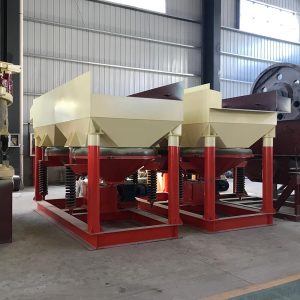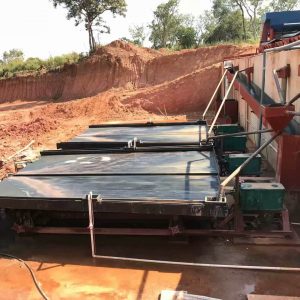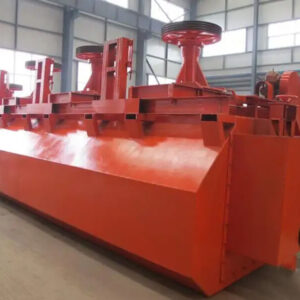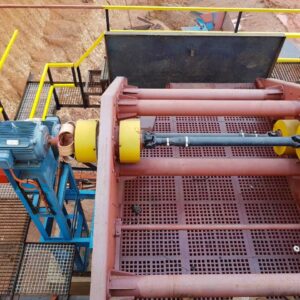The raw ore grade of diamond is very low, and the minimum recoverable grade stipulated is several times or even more than ten times lower than that of foreign countries (South Africa, Zaire, etc.). For example, a rock diamond’s minimum recoverable grade is 0.075~0.15ct/m3, and a placer diamond is 0.01 ct/m3. To select diamond particles from such poor raw ore, one must use complex beneficiation methods, multi-stage grinding, and a multi-stage selection process to complete.
Diamond Beneficiation Methods
The most important thing in the diamond beneficiation process is to protect the diamond crystals from being damaged. Otherwise, it will significantly affect their use value. Commonly used diamond beneficiation methods are:
- Roughing: Washing pan beneficiation, jigging beneficiation, heavy medium beneficiation.
- Concentration: X-ray electro-mineral processing, oil-rich mineral processing, surface flotation, magnetic mineral processing, electric power processing, heavy liquid mineral processing, chemical treatment (alkali fusion method), froth flotation, magnetic hydrostatic separation, selective grinding and screening, hand selection, etc.
The main beneficiation methods of diamond
Selection Stage
| Beneficiation Method
| Principle | Main Feature | Applicable Particle Size Range/mm /mm |
| Roughing | Washing pan beneficiation | Density difference between diamond and gangue | The equipment is simple in structure and can be manufactured on site; the recovery rate is high, up to 98%-99%, and the water consumption is low. | 0.5-30 |
| Jigging beneficiation | Density difference between diamond and gangue | The process is simple, the operation and management are convenient; the separation effect is good, the recovery rate is high (97%-100%), the concentrate mineral rate is low (2%-5%); the unit water consumption is large (50-100t/h), and the production capacity Low 10-15t/h. | 0.5-30 | |
| Heavy medium beneficiation | Density difference between diamond and gangue | The separation efficiency is high, the recovery rate of heavy minerals and diamonds can reach 100%; the production capacity is large, up to 80-90t/h; but the whole process is complicated; the equipment wears quickly (when using a heavy medium cyclone). | 0.3-40 | |
Concentration | X-ray electro-mineral processing | Differences in fluorescence between diamond and gangue | High sorting efficiency, recovery rate up to 100%; high degree of equipment automation, but complex equipment structure and high maintenance requirements; high equipment price. | 0.2-30 |
| oil-rich mineral processing | The difference of lipophilicity and hydrophobicity between diamond and gangue | The sorting effect is good, and the recovery rate is 90%-98%; Low concentrate rate (about 0.5%); But there are many factors that affect the effect of sorting; The operation is more troublesome; The sorting effect is significantly worse in the presence of diamonds with poor lipophilicity | 0.5-20 | |
| surface flotation | The difference of lipophilicity and hydrophobicity between diamond and gangue | The equipment structure is simple; The separation effect is similar to that of ointment beneficiation, but the rate of concentrate is higher than that of oil beneficiation; small production capacity | 0.2-2 | |
| magnetic mineral processing | Magnetic difference between diamond and gangue | This method is used when the raw ore contains more magnetic separation differences. | 0.2-3 | |
| electric power processing | Density difference between diamond and gangue | The recovery rate is about 90%, and the concentrate rate is relatively large; Strict operating conditions are required; The sorting efficiency is difficult to stabilize. | 0.2-3 | |
| heavy liquid mineral processing | Density difference between diamond and gangue | The accuracy of sorting according to density is high, and the lower limit of sorting particle size is low, which can reach 0.02-0.03mm; However, heavy liquids are expensive and most of them are toxic, so they are only suitable for selection operations with small processing volumes. | >0.02 | |
| chemical treatment (alkali fusion method) | Differences in chemical stability between diamond and gangue | The concentrate rate is small and the recovery rate is high; However, the amount of NaOH is large, and the material cost is high | 0.2-1 | |
| froth flotation | Differences in surface hydrophobicity between diamond and gangue | Low concentrate rate (0.2%-0.3%), high recovery rate (90%-95%), Collector: kerosene, diesel, black medicine(ph=7-9) | 0.2-0.5 | |
| magnetic hydrostatic separation | Synthesis of Density and Magnetic Properties of Diamond and Gangue | The rate of concentrate is low, the recovery rate is about 95%, and the grade of concentrate is about 95%; separation medium: MnCl2, Mn(NO3)2, etc. | 0.2-0.5 | |
| Selective grinding and screening | The difference in wear resistance between diamond and gangue | It is an effective method to reduce the amount of coarse concentrate that enters into the selection, but diamonds with incomplete crystals and defects are easily ground, and generally should be used after recovering a large number of diamonds. | <10 | |
| hand selection | Differences in luster, hardness and quality between diamond and gangue | It is the final process of obtaining diamond tea farmers. | >1 |
It is pointed out in the above table that the division of roughing and selection is not absolute, and some methods can be used for both roughing and selection, such as flotation, magnetic separation, selective crushing and screening, X-ray electroselection, hand-selection, etc.,
Diamond Beneficiation Equipment




Diamond Beneficiation Process Flow
The mineral processing process of primary diamond ore mainly depends on the ore’s nature, the beneficiation plant’s size, and other factors. A reasonable beneficiation process should meet the following basic requirements:
- Protection of diamond crystals from breakage or minimal breakage.
- Determine the reasonable number of crushing segments and the appropriate upper and lower limits of the selected particle size.
- Get the highest beneficiation recovery rate.
- Recover fine-grained diamonds and valuable associated minerals as far as possible.
Rough Selection Process
The roughing of primary diamond ore generally adopts a multi-stage crushing and grinding multi-stage separation process. Usually, crushing and grinding include coarse crushing, medium crushing, fine crushing, coarse grinding (rod grinding), fine grinding (ball milling), selective grinding, and other operations. For primary ore, self-grinding (grinding parameters need to be strictly controlled) can also be used instead of crushing and grinding. Using self-grinding can reduce the total number of segments for crushing and grinding, simplify the process flow, save capital investment and reduce production costs.
The roughing process of diamond placer is simpler than that of primary ore. It does not require multi-stage crushing, grinding, and multi-stage sorting process but only needs to carry out ore washing, screening, and desliming before entering the sorting process. Before sorting, there is no need for crushing and grinding, and the raw ore only needs to be washed (crushed), screened, and deslimed to separate large pieces of gravel and fine mud for waste to obtain clean sand. The clean sand is then coarsely selected.
- The beneficiation process of diamond placer and primary ore is the same. Generally, process the coarse-grained grades (below 30mm) by X-ray electro-separation, ointment separation, selective grinding and screening, and hand-selection.
- Treat the medium-sized grades (below 3mm) by surface flotation, magnetic separation, electrical separation, and selection.
- Treat the fine particles (less than 1mm) by chemical treatment, froth flotation, magnetic hydrostatic separation, heavy liquid separation, and other methods.
Concentration
The selection process of diamond ore is the same as primary ore and placer ore.
Coarse particles: X-ray electro-separation, ointment separation, selective grinding and screening, and hand-selection.
Medium-sized particles: Surface flotation, magnetic separation, electrical separation, and selective grinding and screening.
Fine grade diamond: The 1mm fine grade adopts chemical treatment, froth flotation, magnetic hydrostatic separation, heavy liquid beneficiation, and other methods.
